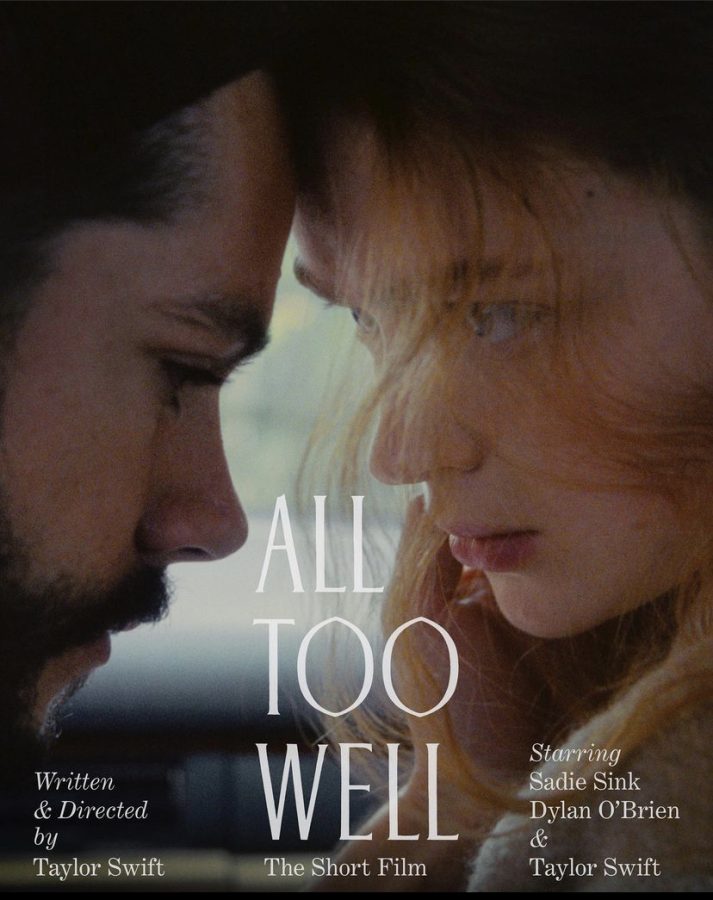Mastering a new medium
Taylor Swift explores new ways of storytelling with the rerelease of her fourth album
Photo Courtesy of Taylor Swift
With the release of “Red (Taylor’s Version,)” fans are welcomed to a new outlook into Swift’s work with the premiere of a short film starring Sadie Sink and Dylan O’Brien.
December 2, 2021
American singer and songwriter Taylor Swift has caught the attention of the media once again as she remasters her 2014 album “Red.” Featuring 30 songs along with a short film to the ten-minute version of the song “All Too Well,” Swift dives deep into her former album.
Due to an expired contract Swift signed in 2005, the recording company she previously worked with owns her first six albums and she is unable to buy them back. This leaves the ownership and Swift’s work in hands other than her own. Erasing any ownership or profits she would’ve received from her previous works, Swift retaliated by remastering each album along with the addition of tracks that were scrapped in the past, resulting in “Red (Taylor’s Version.)”
Having explored different genres of music in the past, she takes on a new medium as she assumes the role of director with the release of a short film. The movie follows the unnamed characters referred to as Her (Sadie Sink) and Him (Dylan O’Brien) throughout their relationship, closely representing Swift’s own experiences. The casting itself was a topic of discussion before the film even came out. Sink, known for her role in “Stranger Things” as a young girl, greatly contrasted O’Brien’s age and experience as an actor. Fans and myself were taken aback at the age gap until I made connections to a past relationship that ended in flames for Swift. The casting choice with two well-known actors proved to be a smart decision, as it caught the attention of fans of Swift and the actors.
With the 10-minute version of “All Too Well” song releasing before the film, fans got a preview of the song that would direct the film. The new verses dived deep into Swift’s former relationship and gave even more depth to what the short film would be focusing on. Even with just the song, Swift once again proves her talent as a writer as she makes a 10-minute song grab the listener’s attention for the entire duration. When I first listened to the song, I went through the emotions that Swift went through the entirety of her relationship. The conviction in her matured voice and her storytelling in her lyrical abilities showcases how she has grown as an artist. On the release day of the album, this was the one song I kept going back to. I anticipated the short film and especially how the cast would work together to portray this relationship.
Opening with the quote “Love is so short, forgetting is so long” by Pablo Neruda, sets the viewers up for the plot of the film and the train ride of emotions they follow the characters through.
Within the first minutes, watchers are greeted with an intimate moment between Her and Him, and the first chapter of their romance, titled “An Upstate Escape,” proceeds. Showcasing visuals that match the lyrics of the song playing in the background, scenes of sappy interactions between the couple establish their relationship and the naive love they share.
Like the song, the bittersweet undertones creep in quickly. The next chapter titled “The first crack in the glass” already shatters the facade of the perfect relationship previously shown. Picturing a dinner party, he is shown laughing, drinking and relishing in the company of his older friends while she sits off to the side visibly uncomfortable. In an attempt to find assurance, she reaches for his hand and he nonchalantly shrugs her off, leaving her even more uncomfortable. Swift’s casting decisions prove worthwhile as most of this film is done without dialogue, with communication done solely through body language and Swift’s soft yet powerful vocals following in the background. After another scene displaying His temper, it shifts to the aftermath of the dinner party. The music stops and he finally catches onto her uncomfortable demeanor and confronts her about it. After an argument full of deflection, the couple “makes up.” The tension between the characters hung over me as I watched the argument play out. Resulting in a half-hearted apology, the music starts back up and hits the watchers like a brick with the lyrics “and I know it’s long gone and there was nothing else I could do.” These lyrics, along with the pathetic excuse of an apology, demonstrate how these little events eventually shatter what she thought was the perfect relationship.
Ignoring the cracks in the glass, the next chapter returns to the intimate and fluffy scenes in the chapter “Are You Real?” These scenes further develop the intimacy and demonstrate the devotion that they both had to each other.
This blissful chapter is cut short with “The Breaking Point.” As the first bridge in the song climaxes, the plot does, too. Without dialogue, another even more intense argument plays out with the female counterpart making a shocking realization resulting in anger. This time, there is no apology, only the devastating scenes of her going through raw heartbreak. For such a young actor, Sink does an incredible job of acting even without any audio. The emotions she goes through during the breakup montage align with the emotions Swift is displaying through her vocals and lyrics.
Flashing forward to a party scene, Sink’s character is once again outcast, but this time due to her own uneasiness. Her eyes keep flashing towards a nonexistent person, and with the help of Swift’s lyrics, it’s implied that the male character was supposed to show up at this birthday party, but didn’t, breaking her heart once again.
The next chapter called “The Reeling” follows. The intense emotion is no longer there; instead, simple realization and numbness replace it. Time goes on which is shown through various clips of her in her bed and in her room. Again, Sink’s talent is displayed once again. Though these clips seem fairly mundane compared to some of the more intense scenes, Sink portrayed the raw emptiness after such an intense ending to a relationship. She exhibits such complex, yet simple, emotions in an effortless way that seems so natural.
The film then cuts to “The Remembering” as the male counterpart walks down a lowly lit street, reflecting on the positive aspects of the relationship. Even with the visual aspects like the filters used and the scenic views, Swift vocals come in even stronger and force the watchers through the heart-wrenching experience of remembering the good parts of a long-dead situation. Focusing once again on her, the second bridge creeps in.
Thirteen years later, an older version of the female character gets ready for an event. This second bridge includes steady vocals and instrumentals which feel bold and assured. Despite still harboring the emotion of the heartbreak, her vocals are stronger, almost confrontational. The character attends a signing and reading event of a book she wrote titled “All Too Well.” Right before the character takes the stage, the camera pans onto her face revealing the artist behind the song, Swift herself. The camera pans to the male character, wearing the scarf that she left at his sister’s house years ago, reflective of the lyrics opening the songs.
From there, soft vocals and instrumentals guide the audience into the credits of the short film. With just a 15-minute film, Swift showcased the dramatics of love in a new way. Personally, the film felt like an extended music video-which isn’t a bad thing. The cinematography, acting and newly released song that played in the background worked well together to create a cohesive and heartbreaking experience for her fans, something perfect for “Red (Taylor’s Version.)” As she continues to re-release more of her previous work, Swift is expected to explore new ways to keep these familiar songs relevant.







